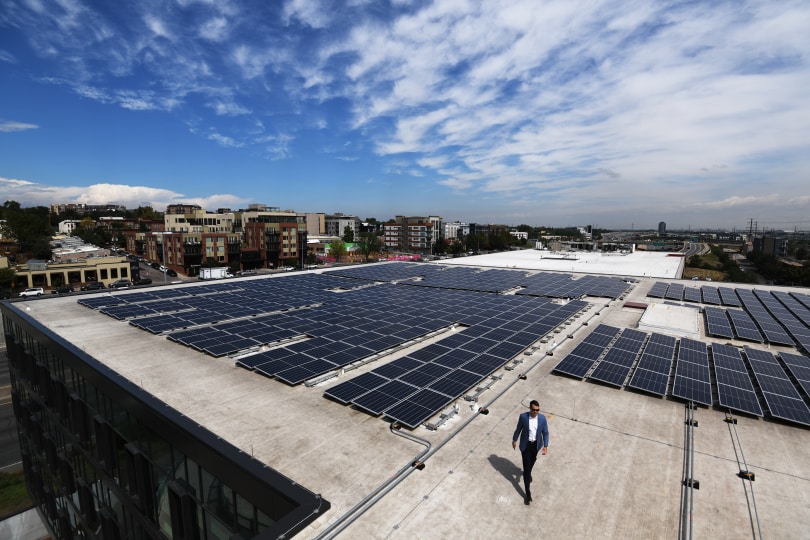
The roof of the Circa Building is covered by solar panels in this photo from September 2018. (Hyoung Chang/The Denver Post)
A Denver task force has created a series of recommendations for existing commercial and multifamily residential buildings to significantly reduce their greenhouse gas emissions over the next two decades.
Members of the Energize Denver Task Force said Thursday that the recommendations — which include using electric appliances — could cut 49 percent of the city’s annual emissions.
The task force stated in its recommendations that commercial and multifamily buildings are the largest contributors of greenhouse gas emissions in Denver and reducing their emissions by 80 percent would bring the city’s buildings closer to “net-zero” energy by 2040.
But the task force is trying to set some deadlines sooner, some by 2025 to 2030, to have larger buildings reduce their energy usage and change to reusable energy sources.
“While this doesn’t achieve the task force goal, it achieves as much as the task force feels is reasonable and achievable for building owners and managers in Denver,” the report stated. “The city should continue to investigate how to close the gap.”
Councilman Jolon Clark, who is part of the task force, said the city’s office of Climate Action, Sustainability and Resiliency will now use the recommendations from the task force to draft the rules, some of which would eventually need to be sent to the full City Council for consideration.
“I am hoping that we may see some of that work its way toward (the City Council) by the end of the year,” Clark told BusinessDen.
Denver’s definition of a net-zero energy building is one that is “highly” energy-efficient, powered by renewable electricity and provides energy to the grid, such as with solar panels. But even with the recommendations the task force published, Denver won’t reach the desired levels of greenhouse gas emissions, members said.
Proposed new buildings would have to follow the standards of the recommendations as well. The task force worked from January through August to develop the recommendations in the report.
The first recommendation is for the city to come up with a method that would reduce overall energy use of multifamily and commercial buildings and incentivize them to install appliances that would not use fossil fuels. Solar panels, for example, that are on the building would be credited toward that goal.
The second recommendation is to use a phased approach to changing water and space heating devices that use fossil fuels to electric appliances by 2030 in multifamily residences and commercial buildings, but the first phase would begin in 2025.
The recommendation is also for the city to offer incentives for owners to do cost analyses for replacements, make permitting processes for replacements easier and to require heat pumps when necessary.
For buildings where owners don’t control what energy system is used because that decision has been left to the tenants, such as retail buildings and warehouses, task force members said city staff should investigate whether an exemption is needed.
The third recommendation is to provide other incentives that help building owners achieve their goals in reducing their greenhouse gas emissions.
Buildings more than 5,000 square feet and less than 25,000 square feet would be able to substitute certain changes to meet their energy efficiency goals, such as installing LED lighting and solar panels.
For buildings larger than 25,000 square feet, the task force said the city’s Climate Action, Sustainability and Resiliency office will develop certain extensions or alterations for meeting those deadlines, such as for manufacturers.
Buildings more than 100,000 square feet can also come into compliance under different options, so long as they reduce their total energy output.
Buildings that have difficulty coming into compliance could receive help from the city, task force members said, as there are recommendations to keep the costs low for upgrading certain properties so they don’t burden owners or tenants.
“The buildings that are not in compliance are typically those that need a lot more support,” said
Stephen Shepard, executive vice president of the Denver Metro Building Owners and Managers Association and a task force member. “We want more opportunity for the city to get the plan in place instead of creating this (enforcement) system, and obviously … the city will have some opportunity to create some ramifications.”
According to Denver code, all buildings larger than 25,000 square feet must report their energy performance. The city publishes the data on an online map at www.energizedenver.org. All eligible buildings would have to comply with reporting by 2030.
The city’s benchmarking ordinance has seen greater than 90 percent compliance every year since 2016, but Denver is still not on track to reach its emission reduction goals, according to the task force.
A sales tax approved by voters to help Denver reach its climate goals equitably has up to $40 million in funding each year for the Climate Protection Fund.

The roof of the Circa Building is covered by solar panels in this photo from September 2018. (Hyoung Chang/The Denver Post)
A Denver task force has created a series of recommendations for existing commercial and multifamily residential buildings to significantly reduce their greenhouse gas emissions over the next two decades.
Members of the Energize Denver Task Force said Thursday that the recommendations — which include using electric appliances — could cut 49 percent of the city’s annual emissions.
The task force stated in its recommendations that commercial and multifamily buildings are the largest contributors of greenhouse gas emissions in Denver and reducing their emissions by 80 percent would bring the city’s buildings closer to “net-zero” energy by 2040.
But the task force is trying to set some deadlines sooner, some by 2025 to 2030, to have larger buildings reduce their energy usage and change to reusable energy sources.
“While this doesn’t achieve the task force goal, it achieves as much as the task force feels is reasonable and achievable for building owners and managers in Denver,” the report stated. “The city should continue to investigate how to close the gap.”
Councilman Jolon Clark, who is part of the task force, said the city’s office of Climate Action, Sustainability and Resiliency will now use the recommendations from the task force to draft the rules, some of which would eventually need to be sent to the full City Council for consideration.
“I am hoping that we may see some of that work its way toward (the City Council) by the end of the year,” Clark told BusinessDen.
Denver’s definition of a net-zero energy building is one that is “highly” energy-efficient, powered by renewable electricity and provides energy to the grid, such as with solar panels. But even with the recommendations the task force published, Denver won’t reach the desired levels of greenhouse gas emissions, members said.
Proposed new buildings would have to follow the standards of the recommendations as well. The task force worked from January through August to develop the recommendations in the report.
The first recommendation is for the city to come up with a method that would reduce overall energy use of multifamily and commercial buildings and incentivize them to install appliances that would not use fossil fuels. Solar panels, for example, that are on the building would be credited toward that goal.
The second recommendation is to use a phased approach to changing water and space heating devices that use fossil fuels to electric appliances by 2030 in multifamily residences and commercial buildings, but the first phase would begin in 2025.
The recommendation is also for the city to offer incentives for owners to do cost analyses for replacements, make permitting processes for replacements easier and to require heat pumps when necessary.
For buildings where owners don’t control what energy system is used because that decision has been left to the tenants, such as retail buildings and warehouses, task force members said city staff should investigate whether an exemption is needed.
The third recommendation is to provide other incentives that help building owners achieve their goals in reducing their greenhouse gas emissions.
Buildings more than 5,000 square feet and less than 25,000 square feet would be able to substitute certain changes to meet their energy efficiency goals, such as installing LED lighting and solar panels.
For buildings larger than 25,000 square feet, the task force said the city’s Climate Action, Sustainability and Resiliency office will develop certain extensions or alterations for meeting those deadlines, such as for manufacturers.
Buildings more than 100,000 square feet can also come into compliance under different options, so long as they reduce their total energy output.
Buildings that have difficulty coming into compliance could receive help from the city, task force members said, as there are recommendations to keep the costs low for upgrading certain properties so they don’t burden owners or tenants.
“The buildings that are not in compliance are typically those that need a lot more support,” said
Stephen Shepard, executive vice president of the Denver Metro Building Owners and Managers Association and a task force member. “We want more opportunity for the city to get the plan in place instead of creating this (enforcement) system, and obviously … the city will have some opportunity to create some ramifications.”
According to Denver code, all buildings larger than 25,000 square feet must report their energy performance. The city publishes the data on an online map at www.energizedenver.org. All eligible buildings would have to comply with reporting by 2030.
The city’s benchmarking ordinance has seen greater than 90 percent compliance every year since 2016, but Denver is still not on track to reach its emission reduction goals, according to the task force.
A sales tax approved by voters to help Denver reach its climate goals equitably has up to $40 million in funding each year for the Climate Protection Fund.

